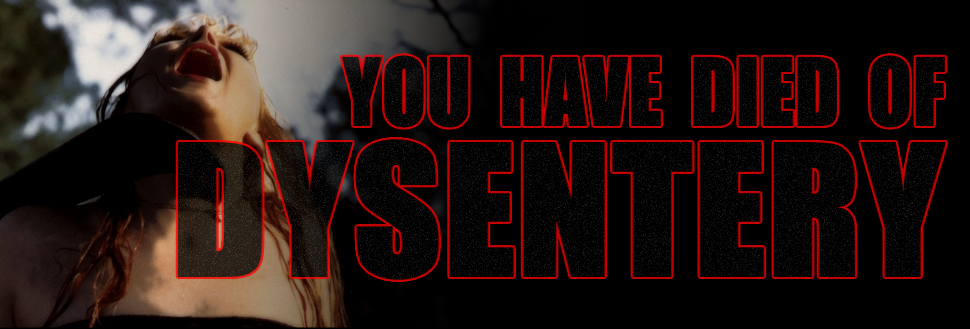The warning bells
began ringing right from the start. The first sound I heard was an
upbeat, jazzy brass arrangement. Over an empty black screen, a 36
second long bit of old-timey voice-over narration told me all about
glorious Hollywood and the promise of stardom. When the credits
finally arrived, they were presented in the style of silent film
intertitles and contained names like Alan Hale, Cameron Mitchell,
Aldo Ray and Dan Haggerty. “Oh no”, I thought to myself, “this
isn’t going to be a low budget attempt at a period piece, is it?”.
Thankfully, the answer was no.
A montage of silent
film footage and 1920s movie ephemera gives way to the modern day.
Alan Hale shares a few words with a real estate agent. They are at
the home of Lance Hayward, a 1920s matinee idol whose career was sunk
by the arrival of the talkies. Hayward went missing shortly after
that, abandoning fame and film for parts unknown. Many believed him
to be dead, but as we’ll soon find out, Hayward is still very much
alive and kicking. Hale wanders off camera, his paycheck earned for
the day, leaving our real estate agent all alone. He winds up being
drawn and quartered with his own car. When his partner, played by
good old Grizzly Adams, arrives late, he’s quickly dispatched with
a spear to the gut.
We then move on to
our requisite gaggle of college aged nincompoops, including Final
Girl Kathy and awkward film nerd Chip. Seeing as the old Hayward
Estate is scheduled for destruction, our group decides to give it a
proper send off. They sneak into the property, eventually running
afoul of a muscle-bound biker and his floozy girlfriend. Arguments
erupt and fists are thrown. But they all have something much more
important to worry about. Hayward is bumping them off one by one, the
manner of execution changing with each vintage costume he puts on.
Nick Marino’s
BLOODY MOVIE (a title so generic that I’m shocked it had not been
used a dozen times by 1987) sounds like a comedy, doesn’t it? Like
some giggle worthy rip off Vernon Zimmerman’s 1980 slasher FADE TO
BLACK, another film about a serial murderer whose methods change
depending on which Golden Age of Hollywood character he’s currently
dressed up as. I mean, a movie featuring a killer in his 90s would be
played for laughs, right? Well, no, BLOODY MOVIE isn’t a comedic
film, at least not intentionally.
I think we’re
supposed to take all of this seriously. I think we’re supposed to
be frightened by a nonagenarian maniac. I think we’re supposed to
be on the edge of our seats as the killer inches ever closer to
victims who, for some reason, never try to run away. I think we’re
really meant to buy into all of this, as if there ever existed in
1987 a group of college kids who actually enjoyed watching silent
movies and knew all about the dangers of aged nitrate film reels
(and I really do have to wonder if this movie didn’t play some
small part in Tarantino’s writing process for INGLOURIOUS
BASTERDS).
Or maybe we’re
just not meant to think at all as the film goes along. It’s
certainly easy not to as Marino and Co. keep the deaths coming at a
steady pace. While cheap, some of the effects work is rather good,
especially the aforementioned bisection via car and a gnarly,
mid-film decapitation. The presence of ex-porn actresses Michelle
Bauer and Jamie Summers ensures the requisite nudity, and overall,
the cast performs as well as you could expect with Z-grade material.
If you just switch your brain off, you might actually be able to get
through BLOODY MOVIE without punching yourself in the face.
Unfortunately for
yours truly, I simply couldn’t get into the groove with this film,
largely because of some horrible directing and editing choices. Each
murder is preceded by a clip show from various silent movies (used
here in such a manner that I’m surprised Marino and Co. weren’t
sued into oblivion) and ridiculous montages of movie posters and
stills. I get it. It’s a gag, not much different from the Gore Gong
and Hooter Honk gags in CEMETERY HIGH, but dude… It seriously kills
the pacing here. Not only do we get these montages before the start
of the set piece, we return to them during the set piece. It kills
the momentum and it strangles every ounce of possible tension out of
these scenes. Why not just show the characters wandering through the Hayward Estate, stopping to look at a series of movie posters? Look,
here Hayward played a pirate. Here he played an archer. Here he
played a warrior. Audiences would connect those dots. But no, time
and time again, Marino kills the pacing of his own film for the sake
of boring montage.
But it's the final
20 minutes that really sink the ship. Instead of playing it straight
with their audience, Marino and his writing team decide to go full-on
supernatural, ditching the already weak motive for the killings
(which boiled down to “they didn’t like my voice”) for an even
more ridiculous motive. Turns out, Hayward is a Satanist striving for
immortality, lashing out at the world because… well… they didn’t
let him play Othello or some shit. I’m not really sure. All I know
is watching a slasher movie villain (in light black face, no less!) manhandle the
Final Girl while poorly performing Shakespeare is really not a
satisfying or thematically appropriate conclusion.
In summary, BLOODY
MOVIE is definitely a bloody movie. Michelle Bauer takes her clothes
off, we learn a valuable lesson or two about film stock and the
advent of sound, get to spend three whole minutes with the great
Cameron Mitchell, and the entire shebang ends with someone being
aggressively kissed to death. Viva la Cinema.




